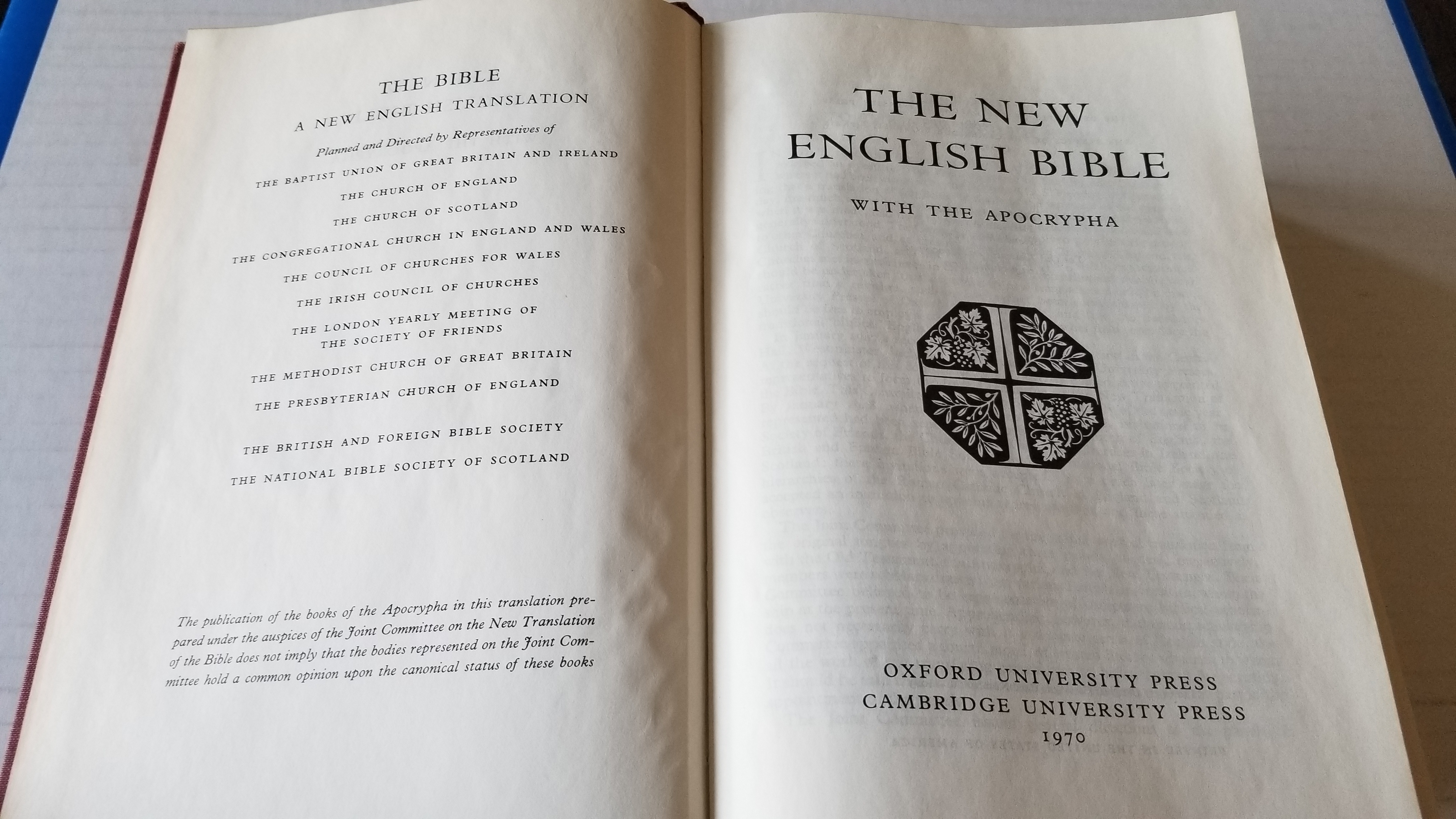
I was browsing the bible section of a used bookstore a few weeks ago and came across an exciting find: an old hardcover Oxford/Cambridge edition of the New English Bible (NEB) with Apocrypha. This is the first time I’ve laid my hands on a complete copy of the NEB, which was the precursor to my much beloved REB. The complete bible is no longer published in a single volume. The only edition still in print is a paperback edition in three volumes from Cambridge University Press.
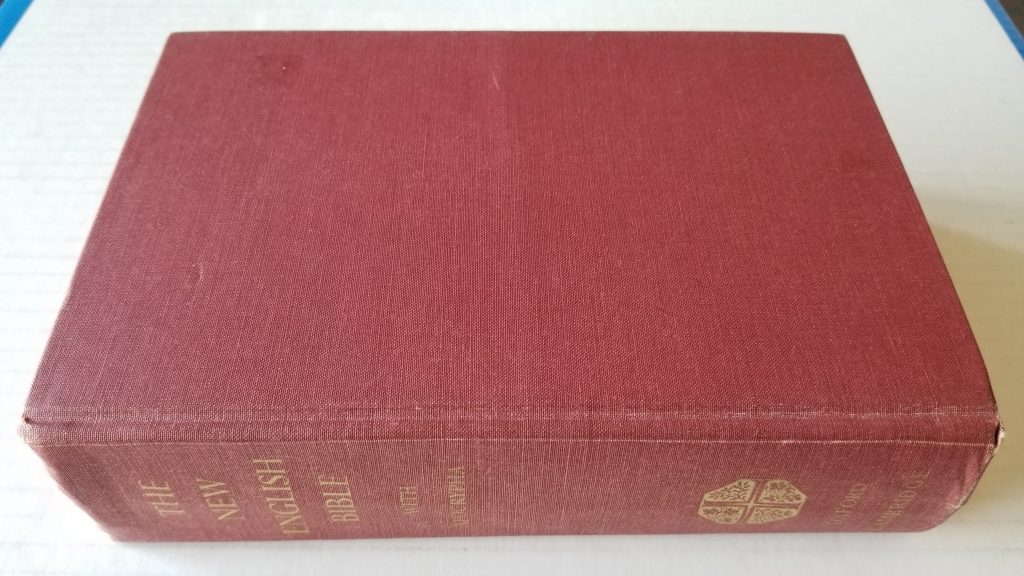
As a brief background, the process of translating the NEB began after World War II. At the time, the King James version was widely used in the liturgies and services of the mainline protestant denominations in the British isles. Regular churchgoers had little interest in a new translation, but church officials realized that many non-religious people struggled with the language of the King James version. A group of mainline protestant denominations commissioned a new translation which could introduce non-religious people to the Bible and help them understand the King James version better.
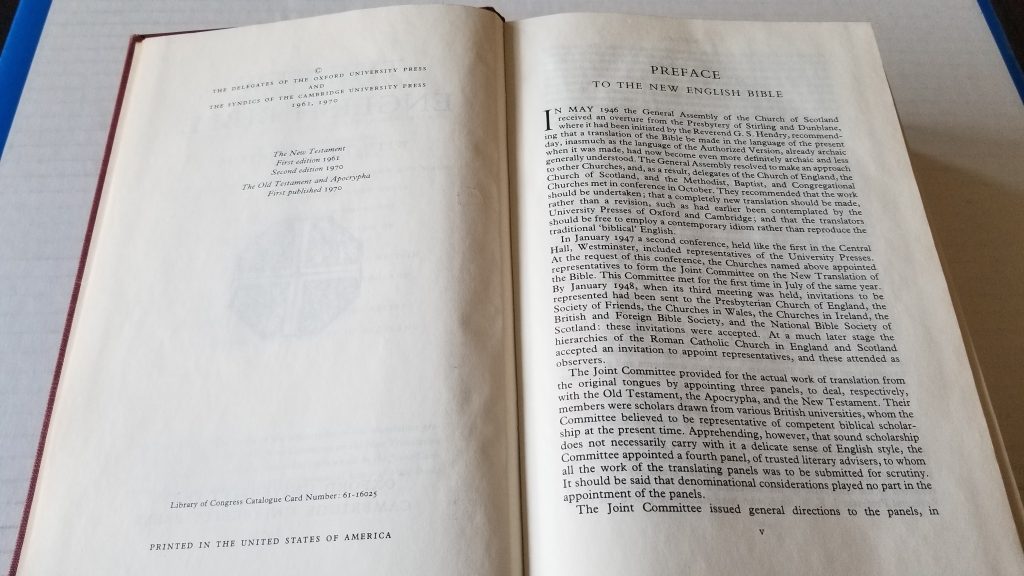
The end result was the New English Bible, which was published as a complete bible in 1970. The Catholic Churches of England, Wales, Scotland, and Ireland became involved in the joint committee sponsoring the translation after Vatican II, and selections from the NEB (along with a few other translations) are used for scripture readings in the Divine Office for Catholics in the British Isles.
The NEB uses the same convention for archaic language as the Revised Standard Version (RSV). All prayers addressed to God use the thee/thou archaic forms, but the rest of the narrative and dialog portions of the text use “you”. The NEB was published just 4 years after the original Jerusalem Bible in Britain, and both editions featured a single-column text format.
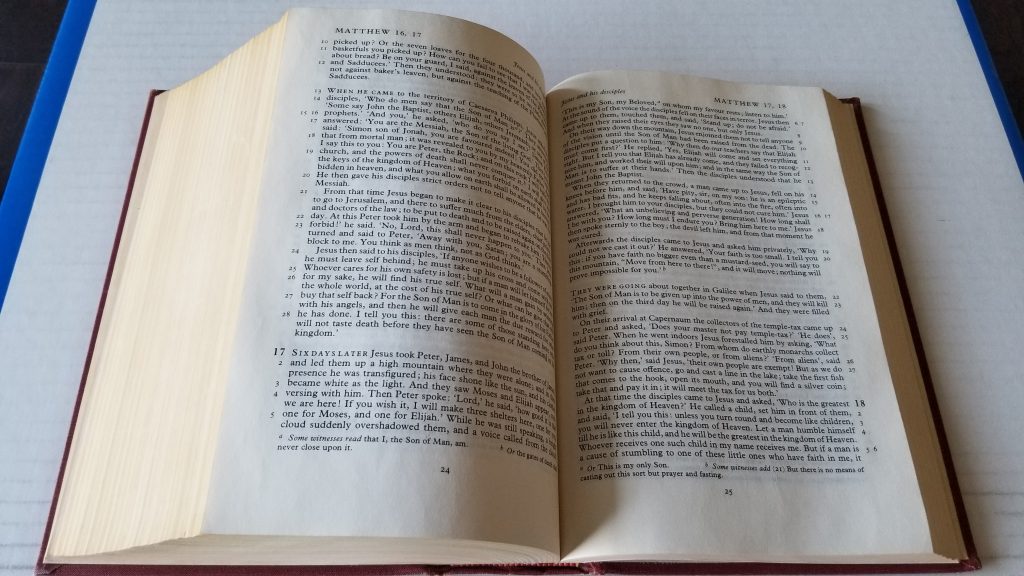
As I thumb through the pages of this old hardcover NEB, I really enjoy the single-column format. I’m often puzzled at the rarity of single-column bibles. They are thicker because single-column pages usually cannot fit as much text per page as double-column pages, but it’s such a joy to read a single-column bible — especially in the poetic books.
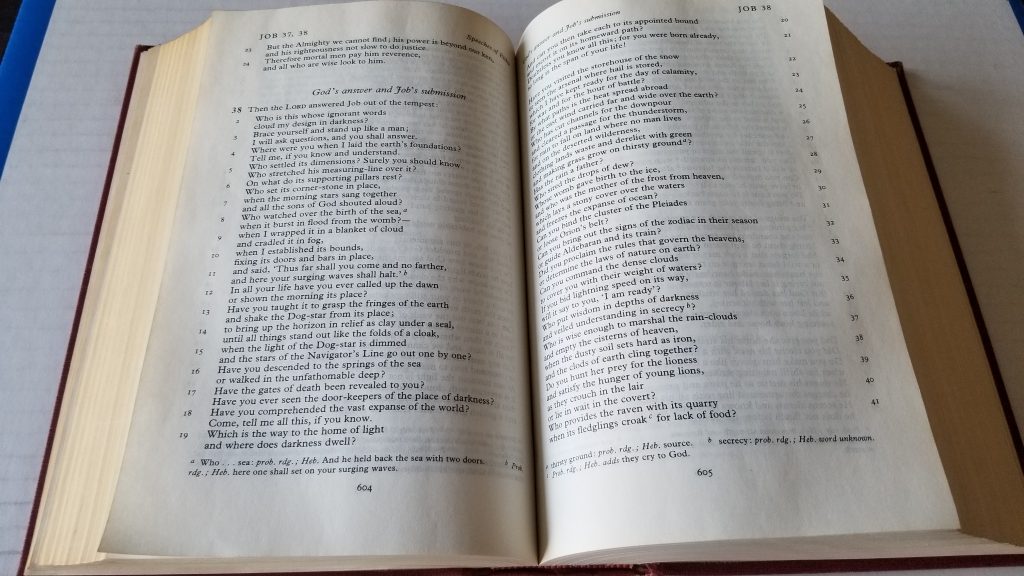
Marc, the Bible you have pictured is the exact same Bible edition I am reading right now! I have long had a soft spot in my heart for the NEB, and when you put up the weekly comparisons of the REB vs.the NABRE I refer to my NEB as well to see how each version stacks up to each other. I hope you enjoy your NEB as much as I do mine!
These editions are quite prevalent in used book stores, and even thrift stores (in my experience). Supposedly, Venerable Archbishop Fulton Sheen spoke favorably of the translation. I’ve never encountered this comment, thus I can only presume that Sheen did comment as some have noted. T.S. Eliot, however, stated the NEB, “…astonishes in its combination of the vulgar, the trivial and the pedantic.” [Eliot, T.S. (1962-12-16). “Letter: Review of the New English Bible”. Sunday Telegraph: 7.; http://www.bible-researcher.com/neb-eliot.html%5D.
The NEB NT was published in 1961, in a single volume (in hardcover, leather, paperback, cardboard editions), and the complete bible was published in 1970 (with the 2nd edition of the NT). The NEB was replaced by the REB in 1989.
The NEB translation uses dynamic equivalence (similar to the Jerusalem and Knox Bibles). It maintains non-gender inclusive language, as the REB has included gender-inclusive language.
James, I’ll grant you that the NEB can be, well, quirky in places. It also be magnificent, as in the poetry of the Book of Job.
Sheen’s ‘Life of Christ’ utilizes the NEB for all scriptural quotations, so he must have been somewhat favorable towards it.
The Bible Researcher website you reference is really interesting, even if the first thing I learned was that Fulton Sheen and I are the only people on earth who ever liked the NEB! (Ha! Ha!) I plan on spending some more time there looking around.
What are your personal thoughts on the New English Bible? I would love to hear them!
In the sermon/conference “Jesus- Eternal Priest” Bishop Sheen states “…incidentally the bible that I will be using will be the New English Bible. Not the Roseland bible, not the New American Bible, not the Authorized Revised but the New English Bible. Which I find from my Scriptural reading to be the best of them all.” This sermon can be found on http://www.catholicvault.com
I’m watching a talk by the Venerable Fulton Sheen and heard him specify that he will always be reading from the New English Bible. He named it twice. The talk is Titled “Choice”. It’s outstanding.
James, see this video of Fulton Sheen. Around the 11:30 mark, he reads from his bible and says he “always reads from the New English Bible”. I just purchased one on Amazon, thanks to this wonderful Archbishop. May he intercede for us all!
https://www.youtube.com/watch?v=0AsEB1-AT4o&t=694s
I am sure there were churches at the time that were using the KJV, after all, there are some that still do today, but the NEB was not made to replace the KJV, it was made to replace the ‘Revised Edition’ of 1881.
Here is an important point: the reason why the NEB was originally commissioned is that the copyright of the1881 Revised Edition was set to expire in only a few years.
At the time, a copyright could last for a maximum of 70 years, which meant that the copyright on the 1881 text was due to expire at the end of 1951. Since one of the main reasons for the commissioning of a Bible translation was to earn money from licensing it, the expiration of the copyright was a huge problem as it would lead to a loss of revenue. So the decision was made to create a brand new translation that could be copyrighted so they could keep earning revenue from licensing the text.
This same reason, the fact that a copyright was set to expire soon, is also the reason for the creation of the RSV. The copyright of the American Standard Version (basically the same text as the 1881 English Revised Version with a few ‘Americanizations’) was set to expire at the end of 1957, so in 1937 the RSV was authorized.
So, the fact that copyrights tended to expire relatively quickly was a good thing that led to a lot of creativity. No Biblical text copyright could be valid for very long, so publishers had to keep updating and revising to prevent expiration of the copyright.
Today, copyrights last so long that publishers no longer have the motivation to update or revise their texts, so you have a lot of translations that have remained static for a very long time.
I wouldn’t be surprised if copyright royalty income plays a role in the publication of new bible translations, but from what I’ve read, I don’t think copyright royalties were the primary motivation for the NEB. The brief explanation I gave in the post was largely gleaned from Roger Coleman’s book “New Light & Truth: The Making of the Revised English Bible.” He discusses the history of the NEB before moving into greater depth on the revision process that produced the REB. Coleman indicates that there was little motivation to switch to a new bible translation among many regular church-goers. In light of that, the NEB was not intended to be used in church services at all. Coleman depicts the original purpose as an evangelistic tool. It would help those who were not familiar with the KJV’s language to learn the Bible.
The NEB was a completely new translation from the original languages, unlike the 1881 Revised Version, which was a revision of the KJV. If copyright royalties were the only concern, it would make sense to produce a “new revised version,” rather than a totally new translation. I suspect that one of the reasons why the NEB was so polarizing and unpopular among many critics was its newness and difference from the KJV (or the Revised Version, which had probably replaced the KJV in at least some churches). But despite the negative reaction of the critics, churches soon started using the NEB at services — something the translators had not intended.
The NEB is a landmark achievement — a brand new translation with occasional speculative renderings at a time when the church-going public were ambivalent about such a thing. I think an apt comparison would be between the NEB and the original Jerusalem Bible (which were published 4 years apart).
If you can find the original authorization decree, you will see that one of the many reasons given for authorizing a new Bible was indeed the fact that copyright for the 1881 Revised Edition was set to expire soon was indeed listed as one of the reasons that a new version was needed.
As for why they decided to make a brand new translation rather than a revision of the Revised Edition, the reason is that the Revised Edition was held in low regard and was widely panned when it was published. Thus, the Revised Version was regarded as a failure, and thus it was thought that it was not worth the effort to continue with it by making a further revision.
Likewise, the NEB was regarded as a failure when it was released, which is why a revision was authorized almost immediately after publication. The REB is regarded as a success, but by the time it was published, Christianity in England was practically extinct, with barely 10% of the population attending church, so despite its excellence, it has had no cultural impct.
The situation hasn’t exactly gotten better, so it seems unlikely that there will ever be any further revisions due to a lack of interest from the general public and a lack of money to fund a revision. The REB will likely be the last major English Bible translation that will ever be made in the UK.
True (in regard to “comparing” the JB and NEB), as both use dynamic equivalence. An apt comparison would be quite fruitful. In fact, there have been a few (out of print) parallel texts using KJV, NEB and JB. There was one such printed in 1972 (A rather large red hardcover edition at 9 pounds; and approximately 2900 pages!), which supplies the text of the KJV, NASB, NEB and JB. The title was, “The Holy Bible in Four Translations, Parallel Edition”.
Yes, I agree, the difficulty that much of the uneducated laity had understanding the KJV is the reason why the NEB is in modern English. And there were several similar projects being produced at the same time, such as JB Phillip’s NT translation of the NT.
But they could have done a modern English revision of the RV or the KJV and produced something like the RSV. The reason they didn’t is that they wanted to break away from Tyndale/KJV tradition completely.
Ironically, one of the reasons why the REB is such a good translation is that in many key places, it actually goes back to Tyndale, in some passages, it is almost word for word identical to Tyndale, with the exception of eliminating archaic words. The REB is more literal than the NEB. And it is for the better.
I’ver never actually read, or even seen a copy of, the NEB, but everything I’ve read about it in reference books on Bible translations is negative, even hostile. I’ve always wondered if it really is as bad as the reviewers make it out to be.
I’m a big fan of both the NEB and the REB, though I wouldn’t suggest anyone have it as their ONLY translation. (I have the RSV, the NAB, and the Knox as well, which fulfill various needs for me).
I’ve read the short slim book which details the making of the REB, and if it is to be trusted, the NEB was never meant to be A. the only bible owned by a family, or B. used in the liturgy.
It was born because chaplains and vicars in the 1940s were shocked that many of the poor people they met could no longer understand the King James Bible. Naively, the NEB was meant to by some of its creators to be a bible read side by side with the KJV.
The REB was partly a reaction to the reception of the NEB by the Anglican church: how do we alter the REB to make it more liturgically appropriate?
It will never be revised, for all the reasons Biblical Catholic pointed out. Along with the theological works of Rowan Williams, I suppose it will be the last important artifact left by English Christianity.
Literal translations have a music and literary quality all their own–particularly when they follow the KJV, which just based on its long-lived status as THE bible for English speaking Protestants.
At the risk of repeating myself, I find the Jerusalem Bible’s literary reputation to be just that–a reputation. I don’t find that holds up to it being read, but it may be to the taste of many.
I find that the lauds the JB receive would be more appropriate for the NEB/REB, which I feel are quite literary in a plainspoken 20th century literature sort of way.
I think the main reason why the Jerusalem Bible got so much praise for its literary style is due to its relative novelty. It is the first Catholic Bible in fully modern English to be published and people were amazed by its readability compared to Douay Rheims and thus they tended to overcompensate in the praise. In fact, compared to more modern translations like the NAB, NIV or ESV, which are far more fluid and natural, the language of the Jerusalem Bible is rather clunky and awkward.
Neither the Knox nor the RSV CE uses fully modern English, both employ archaic language in some parts, for example, the RSV uses archaic pronouns (thee, thou etc) when referring to God. The Jerusalem Bible was the first Catholic Bible in fully modern English.
I am unable to find this Bible online. I am a Catholic from India and I dont not have access to the physical used book stores in the States or the UK where I could have probably procured it from. Any suggestion where else I may get a copy of this beautiful Bible?
The New English Bible can be read online here: http://www.katapi.org.uk/NEB/IntroContents.php
Every thrift store has one, so it must have been popular. I really like it, especially that it has the full text of 2 Esdras.
Every thrift store has one, so it must have been popular. I really like it, especially that it has the full text of 2 Esdras.
I love 2 Esdras, also. The ‘mystery of human destiny’ in it is described gorgeously. The passages where God challenges the author to explain His mysteries and where God, with a twinge of annoyance, speaks directly to the power and consequences of our behavior, as well as what we are allowed to do for each other, are nowhere else so clearly and succinctly stated.
But my favorite verses in 2 Esdras come before God’s teaching, in chapter 2, vs 33-48. I dream of standing next to Ezra, watching Gid’s people receive their crowns from Christ. What a joy that will be!
I love the NEB. I understand it is not exactly the kind of Bible that is meant to be the only Bible one owns but I just love its language. There might be very few of us in the world who prefer to use this version as their go-to version.
Born in 1950, I was raised on the RSV, which I still deeply appreciate. Upon graduating from college in 1972, I was given a copy of the NEB. This lovely translation has been, from that day to this, my chief — and for many years, only — Bible. It is lovingly translated, the language surges with grace and joy, soothing my heart and increasing my love and appreciation for our God and Father. Today I have two copies of the 1972 NEB, both heavily marked up, and have given a number of (used) copies to others. I now own many other versions of the Bible, but the NEB remains far and away my favorite. I cannot fathom its fall from use, although I gather that after its initial favor among the British, it simply did not get across the pond in large enough numbers to encourage Americans to look into it. There is an elegance, a sacred poesy, to it that sings throughout the entirety of the work. I am deeply sorry that it is not more widely recognized and is no longer in print.
I would rightly agree with you on the beauty of the NEB. I grew up on the KJV and later on have used a number of different translations. I discovered the NEB about 5 years ago when I picked up a copy at a flea market for 8 dollars. It has been a refreshing translation and I would say one that is grossly underated.
When I was a protestant seminary student in the US in the late 80s, I used an NEB Bible I found in a used book store as my casual reading Bible while using an RSV study Bible for my course work. I loved the language of the NEB and found it much more pleasurable to read, with its beautiful writing and one-column format.
A few years later, I lost it during my travels and hoping to replace it, I picked up a pocket version of the REB at the Cambridge University bookstore while visiting England in 1995, not realizing how different the two versions were.
I’ve come to love the REB on its own merits, but was very happy to find a leather-bound version of the NEB in excellent condition on eBay recently for a reasonable price and I now cherish both of them for their own qualities as separate translations. I currently use an NRSV Oxford Annotated Bible as my serious study Bible, but still turn to the NEB or REB when reading the Bible for pleasure.
I absolutely love the Revised English Bible with the Apocrypha. Over the years it has become my go to Bible and the one I read the most. I have this same copy of the NEB though and love the single column format. If only the REB had something similar. There is an Oxford pocket version of the NEB New Testament which might have the most pleasing layout and font size for a NT I’ve ever seen. I think I like the renderings a little more for the NEB NT but overall I do think the REB made improvements in style by tampering down certain strange and infamous translations, and doing away with the archaic language distinction. Love that other people love these translations.
Tom: Gladly and most appreciatively, I was introduced to the NEB when I majored in Religion at the University of South Carolina (USC) (1970). My version is the red hard back, newly published in that same year. Although the religion department was comprised of students from different Protestant denominations, I had been raised as a Southern Baptist. The KJV was the Bible I had grown up with. However, I came to love the NEB as my second favorite. I too, love its clarity and easily read passages, especially for those opposed to reading the KJV.